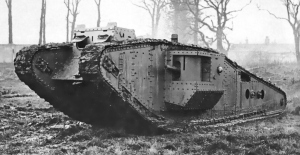I am sure most Lincolnians would understand the relevance of the title of this blogpost.
By Christmas 1914 the opposing armies of the First World War became bogged down in the mud and reached a stalemate: each dug trenches in the battlefields of France and Belgium to consolidate their positions.
In 1915 the Admiralty Landship Committee, through the sponsorship of Winston Churchill, the First Lord of the Admiralty, was formed with the task of developing 'a machine, strongly armoured, carrying guns, capable of negotiating obstacles in the battle area and crossing opposing trenches'.
Major Walter Gordon Wilson of the Naval Air Service and William Tritton of William Foster & Co. Ltd., were commissioned by the Landship Committee to produce the first landship in secrecy.
Fosters were an agricultural machinery manufacturer in Lincoln, their Traction Engines and threshing machines were world-renowned and had worked with Hornsby's of Grantham on the development of tracked vehicles. Foster’s heavy Daimler tractors were already being used to move howitzer guns and other heavy equipment to and on the battlefield.
The main driving force behind the development of the landship was Colonel Swinton, he had witnessed tests of tracked vehicles for military use soon after the start of the war and saw their effectiveness in penetrating enemy positions.
Swinton laid down certain key criteria that were to be part of the finished design: the landship must attain a minimum speed of 4 mph, be able to climb a five-foot-high obstacle, successfully span a five-foot trench, and be immune to the effects of small-arms fire. Furthermore, it should possess two machine guns, have a range of twenty miles and be maintained by a crew of ten men.
To keep the development secret the team met in a room at the White Hart Hotel, Lincoln, which later became known as The Tank Room, and Fosters workers were told they were making ‘water-carriers for Mesopotamia’, which they shortened to ‘tank’.
 |
| Little Willie |
It took just 37 days to produce a prototype, which was given the name 'Little Willie' (named after William Tritton. Little Willie was tested on land adjoining Fosters Wellington works. The tracks kept coming off so it was redesigned with tracks around the body and the profile was curved to assist with turning. this tank was called 'Big Willie', later renamed 'Mother'.
The Lincoln number 1 - This machine was developed in August 1915 and known as "Little Willie" after Sir William Tritton.
Mother - Officially named "His Majesty's Landship Centipede". It first ran on 12th January 1916, it was tested at Burton Park near Lincoln and Hatfield, Hertfordshire. It is the predecessor of all British heavy tanks.
Tanks were in full production in Lincoln by 1916, the original designs being improved as expertise and experience of using them grew, much of the production was outsourced to other engineering companies who had greater capacity, although Fosters were called upon to build tanks in World War II.
Mark I - The War Office placed an order for one hundred tanks in February 1916, 25 were built in Lincoln and 75 in Wednesbury. First used at the Battle of Flers–Courcelette (Battle of the Somme) in September 1916, but they were limited in number and not used effectively, they suffered reliability problems. The Battle of Cambrai in November 1917 saw the first use of tanks on a large scale when an advance of 5 miles was made. The tank had changed the face of warfare.
Mark II & III - Sir Douglas Haig, the British Commander in Chief, placed an order for 1,000 tanks. These were delivered between January and March 1917.
 |
| Mk IV Tank |
Mark IV - The main improvements were in armour, the re-siting of the fuel tank and ease of transport. A total of 1,220 Mk IV were built: 420 "Males", 595 "Females" and 205 Tank Tenders (unarmed vehicles used to carry supplies), which made it the most numerous British tank of the war. The Mark IV was first used in mid-1917 at the Battle of Messines Ridge. It remained in British service until the end of the war, and a small number served briefly with other combatants afterwards. 100 were produced in Lincoln.
Tanks fitted with machine guns were known as "female", those armed with six-pounder guns "males"
At the end of the war, Fosters returned to agricultural engineering work. In 1927 a new company was formed, Gwynne's Pumps, to acquire the Hammersmith Ironworks of Gwynne's Engineering Co which was in liquidation. The manufacturing was later moved to Lincoln. W Foster & Co and Gwynne's Pumps were acquired by W H Allen Sons & Co in 1961 and the Waterloo Street Foundry later demolished, but the road which runs through the tank testing site has been named Tritton Road in honour of Sir William Tritton.
Each town or city that raised money through War Bonds was offered a de-commissioned tank for display. Lincoln's tank was sited at Wickham Gardens but eventually sold for scrap
The Museum of Lincolnshire Life displays a Mark IV tank, known as Daphne built at Foster's in 1917 it saw action at the Battle of Cambrai. At the end of the war it was one of the tanks sent to the Bovington Training Camp. In the early 1980s the Bovington Tank Museum released Daphne on permanent loan to Lincoln City Council on condition it was restored. The restoration by apprentices from Ruston Gas Turbines (Now known as Siemens) was completed in about 2 years.
 |
| Daphne at the Museum of Lincolnshire Life |
10th May 2015 - A memorial to the designers and all those involved in the building of the Lincoln tank was unveiled.
Article originally posted on Wordpress 15-08-2013




















